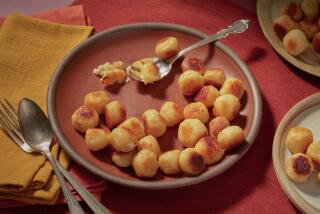UP FROM A WURST-CASE SCENARIO
- Share via
BERLIN — It is still possible to visit Germany and return home believing that German cooking consists of little more than sauerbraten, sauerkraut, schnitzels, wursts and boiled potatoes served in kitschy surroundings. However, Berlin’s bourgeois Hecker’s Deele and plush Zum Hugenotten showed me that German cooking is far more varied and sometimes even lighter than we usually think it is.
Hecker’s Deele, an unabashed champion of Burgerliche Kuche (roughly “everyday cooking”), serves mainly Westphalian and Berlin specialties. (In spite of appearances there is no national German cooking--even sauerbraten and the various wursts and schnitzels we know come from specific regions of the country.)
When you enter this rambling restaurant for Sunday breakfast (served from 8 a.m. till noon--this is not brunch), you may not notice the handsome tiles, farm utensils and massive beams because you will have trouble tearing your eyes away from the remarkable buffet that greets you.
Its numerous meats, fish, cheeses, salads, pancakes and fruits are artfully displayed against an impressive array of whole country breads of various shapes, sizes, textures and hues. A white-aproned hausfrau-waitress shows you to a table in one of the spacious dining rooms modeled after the special-occasion dining area (the deele) of a traditional Lower Saxony farmhouse-barn complex.
This Sunday buffet shows that the richness of German cooking does not lie in the extravagant variety of ingredients and subtlety of preparation that characterize French and Italian cooking, but rather in numerous homey variations on a few main ingredients.
The satisfying dinners at Hecker’s Deele, over which German families spend two or more hours, reveal that German cooking is based on the limited number of food products produced in Germany. This limitation results in an unusual emphasis on game, nuts, berries, wild mushrooms, a few fish and the ubiquitous potato--and a cuisine that is strongly responsive to the seasons.
Winter in Berlin. The streets are depressingly dark and cold but inside Hecker’s Deele it is warm and comforting and--most important of all--the seasonal game menu has been inserted into the regular menu.
After easing into my restorative meal with a full-flavored Wachtel-- or Fasanenconsomme (quail or pheasant consomme)--I go on to an enticing and well-prepared main dish: Wildente mit Maronen (roast wild duck with chestnuts), Springbockkotelette mit Sauerkirschen (grilled Cape antelope chop with sour cherries) or Barensteak in eineger Sauce mit Pfifferlingen (sauteed bear steak in its own gravy with chanterelles)--each made from game taken under government supervision.
These richly flavored meats are usually served with potatoes and a hearty winter vegetable such as Schwarzwurze l (salsify) and Wirsing (savory cabbage) or Sauerkraut or Apfelrotkraut (red cabbage cooked with apples and vinegar).
It is the end of April. The trees in the Grunewald and on the Kurfurstendam are green again and asparagus season has started. From now until mid-June Germans will find as many ways as possible to enjoy fresh asparagus--especially white asparagus. I choose from among the 19 entries on Hecker’s Deele’s asparagus menu insert.
Perhaps an all-asparagus dinner: Spargelessenz mit Klosschen und Eierstich (white asparagus soup with small dumplings and egg custard cubes). Schinkenrollchen mit frischen Stangelspargel (rolls of sliced cooked ham with boiled white asparagus) followed by Frischen grunen Spargel mit Haselnuss sauce (steamed green asparagus with hazelnut sauce).
The year-round menu, of course, offers various pork, beef and herring dishes as well as wursts and sauerbraten. I like ending one of these substantial meals with a hazlenut parfait, ice cream laced with crushed hazelnuts and bits of dark chocolate handsomely presented beneath a corona of deep red sour cherries and their syrup.
Although there is a modest list of German wines at Hecker’s Deele (including a token red) I prefer emulating most of the diners around me by drinking beer which is well-suited to their hearty meals. Dinner, including service, costs about $20 per person.
The French-influenced restaurants of Germany offer the same warm welcome, but the cooking is more delicate and so are the portions. Zum Hugenotten, where the high ratio of staff to diners ensures impeccable service, offers French-inspired cooking served in a plush setting. Unlike Hecker’s Deele, which depends upon local ingredients, the most successful dishes here use imported ingredients to revitalize traditional German recipes.
Rosa sautiere Lammfilets , an attractively presented cold appetizer of small rosy medallions of excellent lamb, was accompanied by a dense and grainy-looking white sauce which said “horseradish” to the eye but “rosemary” to the tongue. In this refreshing variation on German sour cream sauce the native horseradish has been replaced with the fragrant essence of fresh rosemary from Provence.
In Kaninchenfilet in Himbeeressig tender filets of rabbit are surrounded by an understated raspberry vinegar sauce. Especially pleasing accompaniments to main dishes include Brussels sprouts with butter and nutmeg and Williamskartoffeln (potato croquettes in the shape of miniature pears).
Zum Hugenotten’s version of the popular dessert Rote Grutze is a slightly thickened berry-bright compote of fresh red currants, raspberries, wild strawberries and Preiselbeeren (German cranberries). Dinner, including service and wine (a costly investment here), is about $50 per person.
There’s not much chance of going hungry in Germany, but neither is it necessary to resort to tiresome standards. German restaurants can satisfy both the ravenous traveler and the discriminating diner.
Hecker’s Deele, Grolmanstrasse 35. Phone 8890.
Zum Hugenotten (in Intercontinental Hotel), Budapesterstrasse 2. Phone 26020.

